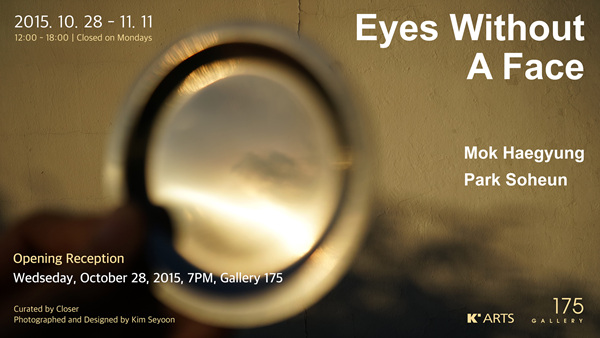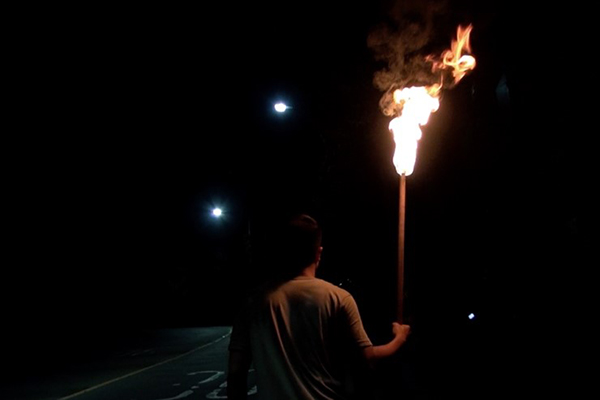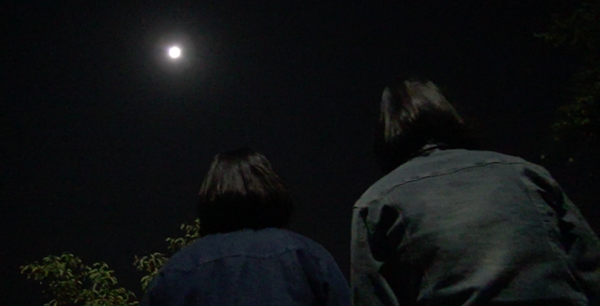얼굴 없는 눈 (Eyes Without A Face)
2015, 갤러리175
10월 28일 ~ 11월 11일
목해경, 박소흔

풍경이 되는 말들
그 자체로 풍경이 되는 ‘말들’이 있다. <얼굴 없는 눈>*이란 제목을 작가들과 나눴을 때, 셋이 잠시 어떤 풍경을 공유하고 있음을 깨달았던 그 순간이 나에게 저 말을 일러준 셈이다. 그것은 당연하면서도 어떻게 보면 당연하지 않은 것이었다. 그 풍경과 순간은 아주 얇은 막이여서 쉽게 비춰볼 수 있는 반면 투과되는 것도 많아 흐릿한 상이 어지럽게 흔들리곤 했다.
전시를 앞두고, 주제기획전이라는 전시의 형태를 생각하면서 그 얇은 막에뚜렷한 상이 맺히도록 해야 하는 건 아닌지 고민 끝에 말을 뱉은 날이 있었다. 몇 마디는 주워 담아야만했던 말이었을지도 모른다. 그 자체로 풍경을 깨트리는 말들이 있다.
말들이 풍경이 되고, 말들이 풍경을 깨트린다. 때문에 글을 쓴다는 것, 작업을 글로 언명한다는 것에 짙은 두려움이있다. 글로 푸는 것에 앞서 감각을 어떻게 관객과 나눌 수 있을까란 질문은 여전히 어려운 것이다. 사적인 감각을 공적인 장에 풀어놓으면서 어떤 풍경을 공유할 수 있는 막을 만든다는 것, 그 막이 그날 우리에게 찾아왔던 순간과 같기를 바란다는 것, 이말이 풍경이 될 수 있을까.
얼굴 없는 눈
본 전시의 제목은 조르주 프랑주 감독의 영화 ‘얼굴 없는 눈’ (1961) 에서크리스티안이 스스로의 얼굴을 더듬으며 각성했던 공포[두려움∙불안∙윤리∙양심∙선언∙심판]의 감각을 빌려오기 위해 차용한 것이다.
온갖 묵시록과 예언, 심판이 난무하던 세기말을 넘어서면서 우리는 마치스스로를 구원한 것처럼, 마치 모든 것이, 우리 모두, 21세기에 태어난 것처럼 그렇게 또-다시, 열다섯 소년으로 태어났다. ‘근대’에 대한 되새김질에도 불구하고“20세기 소년들의 잔혹한 시기(황세준)”는 각성과 복기(復棋)의 감각을 되살리기에는 역부족으로 보인다. 우리는 어쩌다 공포의 감각을 잃어버리게 되었을까.
“우리의 얼굴이 인용이 아니라면, 무엇이란 말인가” 롤랑 바르트의 말을빌리자면, 사건의 현장에서 우리의 얼굴은 멀쩡하다. 공포에 질린 얼굴은 망가진 얼굴일 것이다. <얼굴 없는 눈>은그 얼굴 없는 눈으로 ‘대면’하는 각성과 복기에 관한 이야기다.
목해경 │ Horizon(s)
사자를 만난 프랜시스 머콤버, 카바(Kaaba), 얼음을 처음 만진 마콘도의 어린아이, 페르시아 정원, 닐 암스트롱, 그리고 바벨의 도서관과 회오리 바람 속으로 들어가는 남자.

Horizon(s) 01, 투채널비디오, 12분 45초, 2015

Horizon(s) 02, 투채널비디오, 5분 4초, 2015
Words That Come To Be Landscape
There are ‘words’ that come to be landscape on their own. On sharingthe title – “Eyes without a face” – the moment of realization that the threehad shared a certain landscape for an instant must have told me. This isevident as well as not so obvious somehow. That very landscape and moment is anultrathin screen that is opaque yet see-through, with hazy figures shatteringdiffusely.
With the form of theme-based exhibition in mind, there has been dayswhen words cough out at the end of the struggle to decide whether or not tohave clear figures form upon this ever thin screen. Perhaps some of those wordsshould have been scooped up. There are words that are enough on their own tobreak the landscape.
Words come tobe landscape, and words break the landscape. For that reason, there is heavyfear in declaring the works with writing. The question of sharing the sensationprior to explanatory writings with this audience remains a tricky one.Releasing intimate sensation in a public sphere while building a thin screen onwhich the landscape might be shared. And hoping that this screen would be thesame as the day it came to us. Would this word be the landscape?
EyesWithout A Face
The title of this exhibition is appropriated from Georges Franju’s“Eyes without a face(Les yeux sans visage, 1961)” where Christiane is awokenwith sensation of fear as she gropes her own face.
Beyond the turn of a century,with all sorts of apocalypses, prophecies, and judgments prevalent, we were yetagain, born as a boy of fifteen years old. As if we have saved ourselves, as ifeverything, and we all, were born in the 21th century. Rumination of the‘modern’ notwithstanding, “a cruel period of 20th century’s boys(HwangSeijune)” seems hardly enough to resuscitate the sense of terror. How did wecome to loss the terror?
“If our faces are not quotations,then what are they?” Borrowing from Roland Barthes, our faces are intact in themidst of the scene of action. A face drenched in dread would be a destroyedone. .This is a story about ‘awakening’ and ‘retracing’ from the confrontation ofthose eyes without a face.
Mok Haegyung │ Horizon(s)
FrancisMacomber who met the lion, Kaaba, Macondo’s child who touched the ice for thefirst time, Persian garden, Neil Armstrong, and man swirling into the Libraryof Babel and whirlwind.